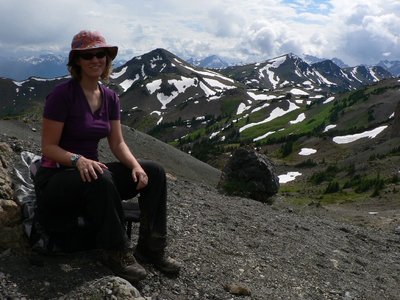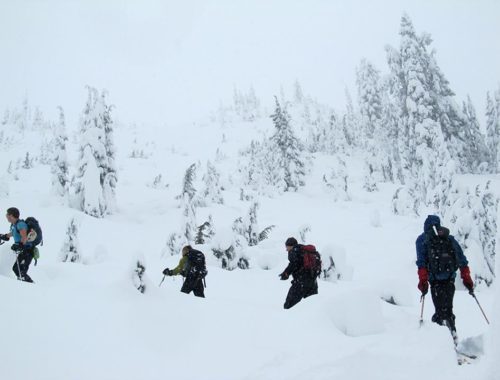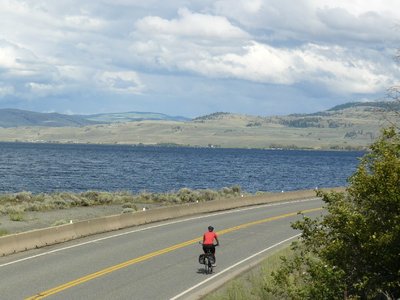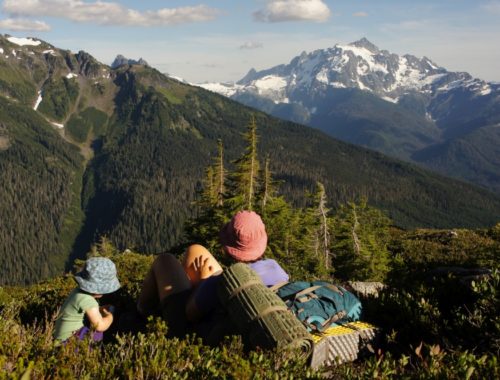
South Chilcotins: Cinnamon and Sugar Mountains
Over the BC long weekend Maya and I spent three days backpacking in the South Chilcotins, located about 5 hours north of Vancouver. We left Vancouver at 4am, just like an alpine start. There was no choice really, since we wanted three full days. The roads were empty and quick, but even before 5am there was a line at the ferry terminal at Horshoe Bay. Just after Pemberton we got on the Hurley Forest Service Road and set in for about 50km of bumpy gravel road. The road is maintained and totally passable in a regular car. There are great views from the road down to the L-shaped Downtown Lake and the peaks behind. The Hurley ends at the tiny town of Goldbridge (population 42 or 43) where you can apparently fill up gas and buy food. From there we drove along Carpenter Lake on a good road, and then up to Tyaughton Lake and more gravel roads.
Just as we got to the trailhead we saw a pickup truck with a half dozen bikes on it. This was a suprise for us, but as we would see later on, the area is very popular with cyclists. Especially the route over Windy Pass, down to Spruce Lake and out through Gun Creek, presumably because of the long downhill sections. The first part of the hike is up an old deactivated gravel road. The flowers were blooming and were just amazing – clumps of purple, pink, yellow, and orange every which way. Every now and then we got a view of the mountains between the trees.
Just after passing the the public use cabin on Taylor Creek we broke out into the alpine and got our first view of Taylor Basin. We didn’t really have a plan set out beforehand, just brought a map and thought we’d figure it out along the way. Our first destination was Camel Pass (AKA Cinnabar Pass). The views over the pass of Cinnabar Basin and the mountains beyond are just magnificent. The mountains in this area are very rounded and coloured in shades of brown, cinnamon, and mauve. Together with the snow and greenery this is an enchanting combination. From there we went over an unnamed pass and into Eldorado Basin. At some stage it started raining and from then on we had periods of light rain and periods of sun, forcing us to continually take our rainjackets on and off.
On the first night we camped on a large meadow by a stream. Just as we had finished pitching the tent, a rainbow showed up just behind the tent. Then it became two rainbows, and then one of them became incredibly strong. It was a great ending to an amazing day. We found shelter from the rain underneath some trees, where we also had dinner and hung our food.
The next day started with an (unintentional) exploration of a side valley – my fault. On the way up to Windy Pass the sky gradually became grayer and grayer and we knew the rain would come later. Just underneath the pass we met a group from the BCMC who were at the end of a 10 day hike. They had flown in to Warner Lake and had done a large loop from there. They were planning on scrambling up Eldorado Mt. on their way out. At the top of Windy Pass the views are somewhat obscured by low hills, so it is best to hike up along the ridge for a few minutes, where you can get 360 degree views.
From Windy Pass we dropped down through the forest to Spruce Lake. After the constant variation on the alpine trails, this trail through the forest felt very long. We rested a bit at the edge of Spruce Lake, and then headed back up the same way we had come. We camped on the second night not far below Windy Pass, in a huge meadow with peaks all around. There are really some beautiful campsites there.
On the third day we crossed Windy Pass for the second time. Just as we were approaching a steeper part of the trail, we saw a black bear about 20m away. He fled, and thanks to the open terrain we could see him for a long long time, making his way across the meadows. Aside from the bear we saw a few naive deer that didn’t even think of running away, marmots and grouse.
A note on directions and access:
We followed Matt Gunn’s directions (for the Harris Ridge) which were very good. Currently it seems that all vehicles park at the fork at 15.5km and not 16.9km as indicated in the book for 2WD (adding 1.4km) and 19.3km for 4WD. It looks like no 4WD has made it up to the footbridge this year, but it still might be possible. Watch for some low waterbars between the threeway fork at 14km and the parking at 15.5km – go slow.
There is an alternate trailhead marked on the map on the Tyaughton Rd, with GPS coordinates. This trailhead provides access to the same area – from there it is possible to connect to the High Trail which makes its way through Cinnabar Basin and over Windy Pass, or to the trail going over Camel Pass and into the Taylor Basin.
A note on maps:
There is an excellent map entitled Southern Chilcotins Trail Map. It costs about $14 at MEC and is waterproof (we tested!) and tearproof (tested!). On the map there are many “Mountaineering Routes”. These are defined as class 1-3. Since the mountains and ridges are very rounded, most ridges can probably be traversed and would make for fun scrambling. The rock looks loose. There are many options here for long hikes and scrambles. Mt Eldorado seems popular.


